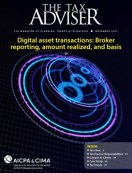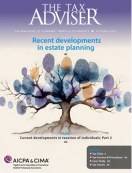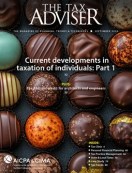- newsletter
- TAX INSIDER

Inherited IRA strategies after the SECURE Act
Please note: This item is from our archives and was published in 2020. It is provided for historical reference. The content may be out of date and links may no longer function.
Related
Government withdraws defense of retirement fiduciary rule
IRS outlines details for Trump accounts
How a CPA and wealth adviser partnership can guide families through transition
When the well-intentioned Setting Every Community Up for Retirement Enhancement (SECURE) Act, P.L. 116-94, was first proposed in mid-2019, I had some concerns. The most troubling aspect of the act was the plan to eliminate the “stretch IRA” provisions for anyone other than a surviving spouse. That provision became effective Jan. 1.
Under the new rules, beneficiaries of inherited IRAs must now withdraw all the money in their inherited accounts within 10 years of receiving it — they can no longer take smaller distributions to stretch their savings over their life expectancy. After the 10th year, any funds left in the account must be taken out and the account closed, regardless of the tax consequences.
“What now?” many account holders worry. “Now that my children can’t use a stretch IRA to receive my IRA funds, how can I control the rate at which they receive their inheritance?” Many successful people are realizing that their heirs will be paying higher taxes on their swelling distributions — and likely forced into higher tax brackets.
I’ve sat through numerous webinars and presentations by leading experts explaining the new rules and the nuances of those rules. However, I haven’t heard much about potential solutions.
One solution that has been touched on is something called a “testamentary transfer to a charitable remainder trust (CRT).” Under this strategy, a CRT (with the taxpayer’s children as beneficiaries) is named beneficiary of a taxpayer’s IRA. When the taxpayer dies, the IRA is distributed to the CRT. Since CRTs are tax-exempt trusts, transferring IRA funds (or other qualified funds) to a CRT will not trigger the recognition of income. The CRT makes distributions to the children over their lifetime or a term of years of up to 20 years.
Structuring the CRT will depend on how old the heirs are at the time the IRA owner dies. That’s because the CRT will have to qualify for the 10% remainder test with a minimum payout of 5%. Younger beneficiaries may not qualify for a lifetime CRT, but a trust with a 20-year term could be a viable substitute. Still, a 20-year stretch is better than 10 years when it comes to deferring tax. Pity the poor attorney who has to draft these instruments with all the possible variables to consider.
One proposed solution that will not work is a rollover to a pooled income fund (PIF). Even though PIFs are charitable trusts, they are not tax exempt. Instead, a PIF trust is a complex trust, which is not taxed, but it must pay out all of its income to the beneficiaries. Regulations permit taxpayers to realize the long-term capital gains that are undistributed and add them to principal. Because the trust is taxable, a rollover from an IRA would be a deemed distribution and, thus, become immediately taxable. Further the PIF would have to consider the receipt of the IRA assets as income to the PIF. Thus, these rules require those assets to be distributed to the income beneficiaries. Not a good result.
Alternatives to the testamentary transfer to a CRT
There are other alternatives to the stretch IRA that provide significantly better results than the testamentary transfer to a CRT. One such solution goes by several names including the “pension rescue,” the “IRA rollback,” or the “pension optimization plan,” to name a few. Clients best suited to use this strategy are those who are in their mid-50s and older who have at least $1 million in their qualified accounts. These funds should have originated in a traditional employer sponsored qualified plan — like a 401(k) or defined contribution plan — and should not have been generated by a “home-run” stock pick in a regular IRA or simplified employee pension individual retirement arrangement (SEP-IRA). In most cases, these are the types of folks who have plenty of other assets to support their retirement. They view “qualified money” as excess funds that will only create future tax liabilities.
It is not unusual for successful families to have a business or other legal entity manage their real estate or investment assets. For these individuals, we typically create a new profit-sharing plan within their entity and roll their IRA funds into the new plan. This is a nontaxable transfer. Here’s what happens next:
- The profit-sharing funds are used to purchase a life insurance policy on the individual or spouse.
- The policy is paid for over two to four years, depending on the circumstances.
- The client pays himself or herself a small salary from the entity.
- Within six or seven years, the policy is appraised and distributed to the insured (or a trust for the insured).
Normally, the appraised value of the life insurance policy is significantly less than the premiums paid. Yet the face amount is significantly more than the IRA funds would have grown to either before or after taxes. This creates tremendous leverage for the family and the heirs, and the SECURE Act is no longer an obstacle for them. Here’s an example of how this technique can work:
Real world example
J is a 64-year-old divorced father of three grown children. He has $817,000 in his IRA — funds he won’t need since he has other significant sources of wealth. J is establishing a limited liability company (LLC) so he can consolidate his assets and accomplish other estate planning goals. His LLC will set up a profit-sharing plan for him and transfer the IRA balance to the new plan. Since he is in very good health, the $817,000 can be used to purchase $3.9 million of insurance. Structuring these policies correctly is the secret sauce. If done correctly, the policy can be distributed to J in five years at a value of approximately $200,000. J will then pay the income tax on the policy of around $80,000 and will then sell the policy to his trust with his children as beneficiaries.
Results
This example illustrates how to solve a problem at very little cost. The funds used to pay for the insurance policy were already in his IRA, so the insurance isn’t costing him extra. He can transfer significant additional wealth to his children without much cost. While there are a few hoops that J and his advisers will need to jump through, those responsibilities are mostly dealt with by the advisory team.
Avoiding inherited IRAs
This type of planning will generally outperform most other options. Be sure to only recommend this solution to healthy individuals who can tolerate some complexity. It’s also important to be sure that they’re not depending on the funds in their qualified plan to support their lifestyle. When those elements come together, the results can be a dramatic improvement over a 10-year stretch IRA or a testamentary transfer to a CRT.
— Randy A. Fox, CFP, AEP, is the founder of Two Hawks Consulting LLC. He is a nationally known wealth strategist, philanthropic estate planner, educator and speaker. He is currently the editor in chief of Planned Giving Design Center, a national newsletter and website for philanthropic advisers. He is a past winner of the Fithian Leadership Award by the International Association of Advisors in Philanthropy. To comment on this article or suggest an idea for another article, contact Sally Schreiber, a Tax Adviser senior editor, at Sally.Schreiber@aicpa-cima.com.














